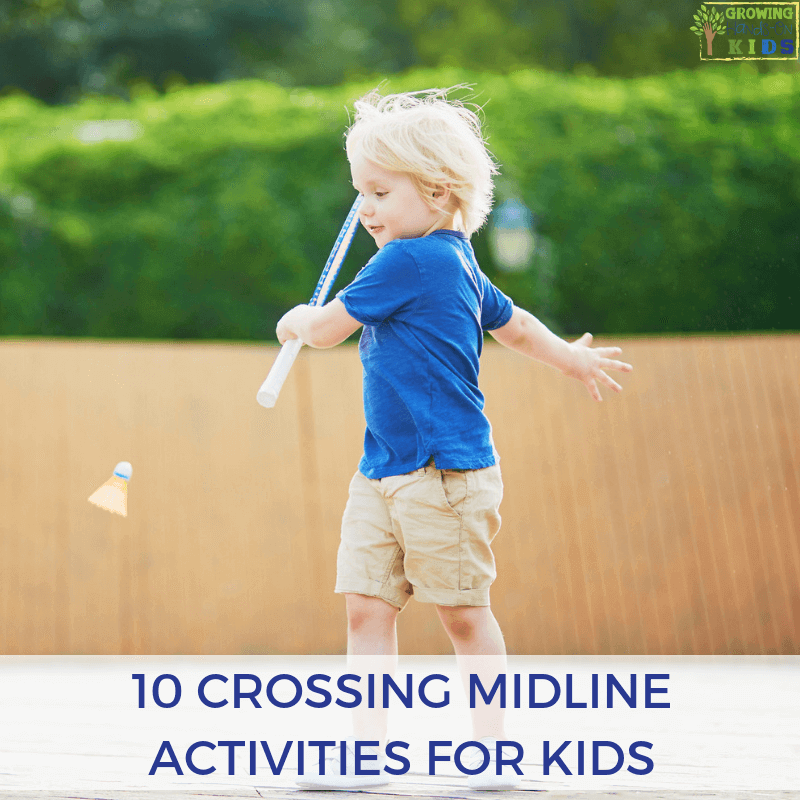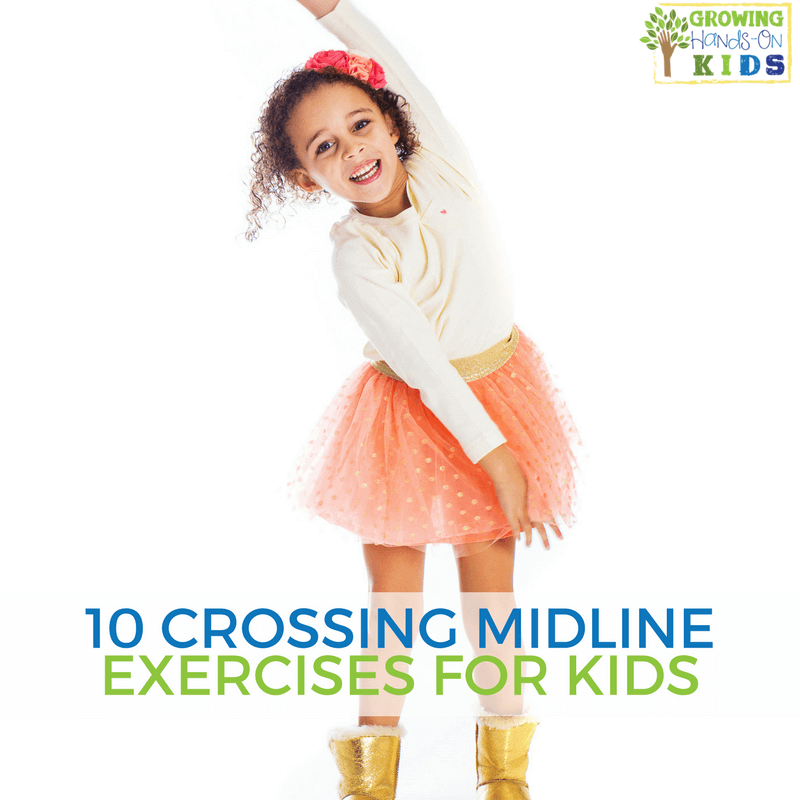10 Crossing Midline Activities for Kids
Affiliate and Referral links are used below to promote products I love and recommend. I receive a commission on any purchases made through these links. Please see my disclosure policy for more details. As an Amazon Associate, I earn from qualifying purchases.
Crossing midline is a term you have probably seen if you work in early childhood education or pediatric therapy. Today I want to share 10 crossing midline activities for kids that you can incorporate into your home, classroom, or therapy sessions.
Why Crossing Midline?
The ability to cross the midline, or cross over the imaginary line that goes down the middle of your body, is important for the development of some very common skills.
Being able to use both sides of the body together in coordinated movement, deciding hand dominance, planning and sequencing, body awareness, and core stability all require the ability to cross the midline.
What does cross the midline mean? It simply means the ability for you or your child to be able to cross over the midline of the body in order to perform a task.
You use this skill when you write, draw, paint, visually track an object, read, perform self-care tasks, and many more.
Here are some fun ways to include crossing the midline practice into your child's day.
10 Crossing Midline Activities for Kids
1 || YOGA POSES
Yoga poses are an excellent way to work on trunk rotation, which is an important skill for crossing midline.
There are many great options for including Yoga in your home or classroom. We use Cosmic Kids Yoga on YouTube. I also really like the yoga cards and products from Kids Yoga Stories.
2 || ROW ROW ROW YOUR BOAT
This activity would be great to use in a group or with younger age children (toddlers and preschoolers).
Have all the children sit with their legs out straight in front of them and begin to sing “row row row your boat.” Have the children pretend to grab hold of a boat oar with both hands.
Pretend to “row” a boat, alternating which side of the body you row on.
If you have a child who struggles with keeping both hands together on an imaginary boat oar, you could use a small wooden stick or a large craft stick for them to hold with both hands.
3 ||PLAYING SIMON SAYS
This popular game for preschoolers is a great way to get some crossing midline practice with your younger child or students. You can have them touch their noses, their opposite ear, arm, elbow, leg, knee, do cross crawls (marching while touching the right hand to left knee and left hand to right knee, etc), or any other ways to get them crossing their body.
4 || DRAWING A RAINBOW
This works best on a vertical surface, but you could use a large piece of paper on top of your table or the floor too. If you are using a vertical surface, a chalkboard or dry-erase board is perfect for this.
Have your child use their dominant hand to draw a rainbow, starting at the opposite side of their body and then ending on their dominant hand side.
So if your child is left-handed, you would have them start at the right side of their body and draw across to the left. For right-handers, they would start on the left and go right.
The trick with this activity is not to let them rotate their trunk or turn their body to the side to reach across. This is a compensation technique you will see many children who struggle with crossing midline do in order to not truly cross the middle of their body.
You can use a sticker or draw a starting and ending point on the board or drawing surface to give visuals if needed.
5 || DANCING WITH STREAMERS
Grab a streamer or long piece of cloth or handkerchief, put on a catchy tune, and start dancing! Mimic each other's moves and be sure to include lots of movement that crosses over the body. Switch hands and use the non-dominant hand too!
6 || ROCK WALL CLIMBING
There are many indoor places that you can go to do rock wall climbing, and even some outdoor playgrounds have them. This is also a great way to practice bilateral coordination and core strength, both of which are needed for crossing the midline.
7 || STRINGING BEADS
Stringing large or small beads is a great way to work on bilateral coordination, and using the dominant hand to string the beads, while the non-dominant hand helps. You'll also want to encourage the child to use the same hand to pull the bead across the string to the end and not switch hands in the middle.
8 || SCOOPING ACTIVITIES
Scooping activities are a great way to have kids use their dominant hand and reach across to pour items. I like to set up the spoon or tongs on the side of the child’s dominant hand and place the items to scoop and pour on the opposite side. This encourages the child to reach across their midline to grab the items and scoop and pour.
Sensory bins are a great way to encourage scooping and pouring. I have a cornmeal sensory bin here that could be adapted for any type of theme or using different sensory items.
9 || PLAY A MUSICAL INSTRUMENT
This can be formal lessons or just playing for fun. Playing music involves so many of the skills needed for crossing midline. Plus, it's fun!
10 || BEAN BAG TOSS
Aim for a target, play corn hole, and any other type of bean bag activity.
You can do this while standing, sitting (either criss-cross applesauce or with legs out front), or sitting on a therapy ball or while balancing on one foot to make it a little harder.
BONUS ACTIVITY – TENNIS/BACKGAMMON
Many sports, like tennis, are great for practicing crossing midline. This would be a great activity for older children and involves lots of visual tracking, along with using the dominant hand to hold the racket.
Get a Free Crossing Midline Activities Download
Subscribe to my weekly email newsletter and get a free printable of 20 crossing midline activity ideas in a PDF handout.
Enter your email address in the form below and click the green “click here” button. You'll be redirected to a success page with a special offer for signing up for my email list. Head to your email inbox to download the crossing midline handout to your computer.
If you have already subscribed to GHOK, don't worry, you aren't actually subscribing again. Entering your email below just lets my email service provider know which printable download to send you. You will not receive duplicate emails from me in the future.
References:
Beer, Magda De. 2015. Crossing the Midline – How Does it Work. Mind Moves Institute, Johannesburg.
Blythe, S. 2009. Attention, Balance, and Coordination. The A.B.C of learning success. West Sussex: John Wiley and Sons
Janet M. Stilwell. 1987. The Development of Manual Midline Crossing in 2- to 6-Year-Old Children. Am J Occup Ther. 41(12):783-789. doi: 10.5014/ajot.41.12.783.
More Reading on this Topic:
Crossing the Body's Midline. 2017 Kid Sense Child Development childdevelopment.com.au
Crossing the Midline – OT Mom Learning Activities
Bilateral Coordination And Academic Performance in Children – Your Therapy Source
Motor Coordination and Academic Achievement – Your Therapy Source
You May Also Like:

Heather Greutman, COTA
Heather Greutman is a Certified Occupational Therapy Assistant with experience in school-based OT services for preschool through high school. She uses her background to share child development tips, tools, and strategies for parents, educators, and therapists. She is the author of many ebooks including The Basics of Fine Motor Skills, and Basics of Pre-Writing Skills, and co-author of Sensory Processing Explained: A Handbook for Parents and Educators.


